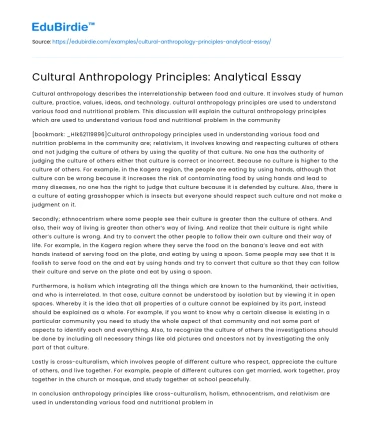Cultural anthropology describes the interrelationship between food and culture. It involves study of human culture, practice, values, ideas, and technology. cultural anthropology principles are used to understand various food and nutritional problem. This discussion will explain the cultural anthropology principles which are used to understand various food and nutritional problem in the community
[bookmark: _Hlk62119896]Cultural anthropology principles used in understanding various food and nutrition problems in the community are; relativism, it involves knowing and respecting cultures of others and not judging the culture of others by using the quality of that culture. No one has the authority of judging the culture of others either that culture is correct or incorrect. Because no culture is higher to the culture of others. For example, in the Kagera region, the people are eating by using hands, although that culture can be wrong because it increases the risk of contaminating food by using hands and lead to many diseases, no one has the right to judge that culture because it is defended by culture. Also, there is a culture of eating grasshopper which is insects but everyone should respect such culture and not make a judgment on it.
Save your time!
We can take care of your essay
- Proper editing and formatting
- Free revision, title page, and bibliography
- Flexible prices and money-back guarantee
Secondly; ethnocentrism where some people see their culture is greater than the culture of others. And also, their way of living is greater than other’s way of living. And realize that their culture is right while other’s culture is wrong. And try to convert the other people to follow their own culture and their way of life. For example, in the Kagera region where they serve the food on the banana’s leave and eat with hands instead of serving food on the plate, and eating by using a spoon. Some people may see that it is foolish to serve food on the and eat by using hands and try to convert that culture so that they can follow their culture and serve on the plate and eat by using a spoon.
Furthermore, is holism which integrating all the things which are known to the humankind, their activities, and who is interrelated. In that case, culture cannot be understood by isolation but by viewing it in open spaces. Whereby it is the idea that all properties of a culture cannot be explained by its part, instead should be explained as a whole. For example, if you want to know why a certain disease is existing in a particular community you need to study the whole aspect of that community and not some part of aspects to identify each and everything. Also, to recognize the culture of others the investigations should be done by including all necessary things like old pictures and ancestors not by investigating the only part of that culture.
Lastly is cross-culturalism, which involves people of different culture who respect, appreciate the culture of others, and live together. For example, people of different cultures can get married, work together, pray together in the church or mosque, and study together at school peacefully.
In conclusion anthropology principles like cross-culturalism, holism, ethnocentrism, and relativism are used in understanding various food and nutritional problem in the community in different ways. Also, it is important to respect, appreciate, and know the other’s culture instead of judging that culture. Because no culture is higher or lesser than another, either that culture is right or wrong.
References
- Bodley, J. H. (2011). Cultural anthropology: Tribes, states, and the global system. Rowman Altamira.
- Crowther, G. (2018). Eating culture: an anthropological guide to food. University of Toronto Press.
- Nanda, S., & Warms, R. (2010). Cultural anthropology. Nelson Education.
- Spradley, J. P., & McCurdy, D. W. (2012). Conformity and conflict: Readings in cultural anthropology. Jill Potash.
- Winthrop, R. H. (1991). Dictionary of concepts in cultural anthropology (No. 11). ABC-CLIO.






 Stuck on your essay?
Stuck on your essay?

